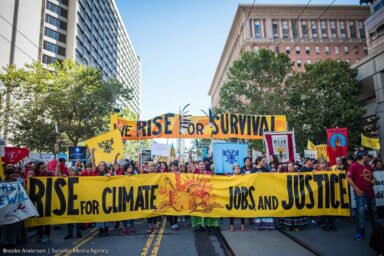There were fissures in our food system long before the coronavirus. Now those fissures are turning into fault lines.
Consumers are finding out the hard way what happens when the global food supply system breaks down.
Shoppers panic over empty food shelves. Farmers, unable to get their products to market, pour millions of gallons of fresh milk down drains.
Lines at food banks stretch down city blocks as unemployment skyrockets. Underpaid migrant farmworkers wait, stuck at borders, as the food they usually harvest is left to rot.
Meanwhile, many meatpacking plants have shut down due to workplace outbreaks of COVID-19. (This Memorial Day, there may be fewer hot dogs.)
According to some experts, the current system is too concentrated, too verticalized, and too corporatized, and the novel coronavirus has only brought these various flaws into starker relief.
We rely on cheap migrant labor to provide low prices, unlimited choices, and instant access to food for those who can afford it. At the same time, 821 million people are “chronically hungry” — approximately 11 percent of the global population.
“Our food systems have prioritized efficiency over resilience,” Fatema Sumar, vice president of Global Programs at Oxfam America, told WhoWhatWhy. Now, the downsides of that choice are harder to ignore.
After many years of consolidation and the expansion of monocropping, the system has become specialized and centralized. There are larger and fewer farms, suppliers, retailers, and processors.
“When a supply chain break occurs in one region or one country, consumers in distant places feel the effect,” Sumar stated. The most recent example of this is in the meat industry.
“America’s farms are still packed with animals raised for meat production,” reported Tara Law in Time. “The problem is that the virus has made it increasingly hard to turn those animals into store-ready packs of pork chops or ground beef. That’s because Tyson and many other meat processing companies across the country have paused operations at a number of plants where workers have tested positive for COVID-19.”
Two-thirds of America’s beef is produced by Tyson Foods and just two other mega-processors. So when they stop working effectively, the whole system collapses. Many other types of crops and meat are equally monopolized, creating similar shortages.
As the supply chain for meat crumbles, the fragility of the food chain becomes clear to those who are used to having access to food at their fingertips. Indeed, President Donald Trump was so concerned about a meat shortage that last month he issued an executive order declaring meat part of the nation’s “critical infrastructure,” making it easier for meatpacking plants to remain open, even as many of their employees continue to become infected with the coronavirus.
Some critics of the corporatization of the food supply chain envision a future with a more durable system created by locally based farms, processors, distributors, and retailers — of all sizes.
“The whole system — the more it can be regionalized and localized the better,” Alison Cohen, the senior director of Programs at WhyHunger, told WhoWhatWhy. This would build safety nets throughout the supply chain, so that if one farm, supplier, or retailer failed, others could pick up the slack, ensuring consumers uninterrupted access to food.
Strengthening local food webs could provide necessary calories during times of emergency, like the current pandemic, that challenge our ability to quickly move goods around the world.
“That doesn’t mean we can’t have global trade,” said Cohen. “I enjoy bananas, avocados, and coffee too.” But, a more diverse food system — one that provides opportunity to small and large producers — would provide resilience in the future. It would reduce vulnerability not only to pandemics, but to climate change, pests, disease, and illness.
“The COVID-19 pandemic is reinforcing pre-existing inequalities and affecting the most vulnerable communities most severely,” said Sumar.
For example, “women and children are among those most at risk when hunger strikes. In many households, women eat last and least. Infants have special nutritional needs to maintain healthy growth and development. If there is not enough nutritious foods to eat, infants will suffer debilitating long-term effects,” Sumar observed.
What’s clear, however, is that hunger is the result not of food shortages but of inequitable access to food.
According to the Food and Agriculture Organization of the UN, 1.3 billion tons of food are wasted across the world each year. That has a value of $2.6 trillion and could feed the 821 million hungry people four times over.
Due to the economic turbulence brought on by COVID-19, more than 500 million people could be pushed into poverty and face hunger. Changing the way our global food system is organized, and thus expanding consumer access to food, could help prevent a food crisis.
“The coronavirus pandemic underscores how fragile food systems are,” Sumar concluded. “A lesson that we need to heed and take action on.”
Related front page panorama photo credit: Adapted by WhoWhatWhy from U.S. Department of Agriculture / Flickr.



